What is a business proposal?
We love helping people to build their business – and today we’re taking a look at business proposals and why they are important. Having the right sort of documents ready to go will result in it being much more likely that you will win business and succeed in the long run. It is absolutely critical that you have a business proposal template ready, and know how to complete them effectively for each proposal you issue – the document is going to win or lose your business contracts! With that in mind, let’s take a look at what a business proposal is, and how to create one.
What is a business proposal?

A business proposal is a document that a business offering a service to a potential client – whether that client is another business or a customer. The document is designed to help convince them that you are the right business to provide that service for them. Businesses typically create a proposal for a customer under three circumstances:
- When a business issues a request for proposal (RFP) which essentially asks you to prove to them why your company is the best one to do the job
- When a potential client has already engaged with you to discuss your services
- Prior to being approached by a client, as an unsolicited proposal
There may be other occasions that you need to create business proposals, but these are the main ones.
Why is a business proposal important?
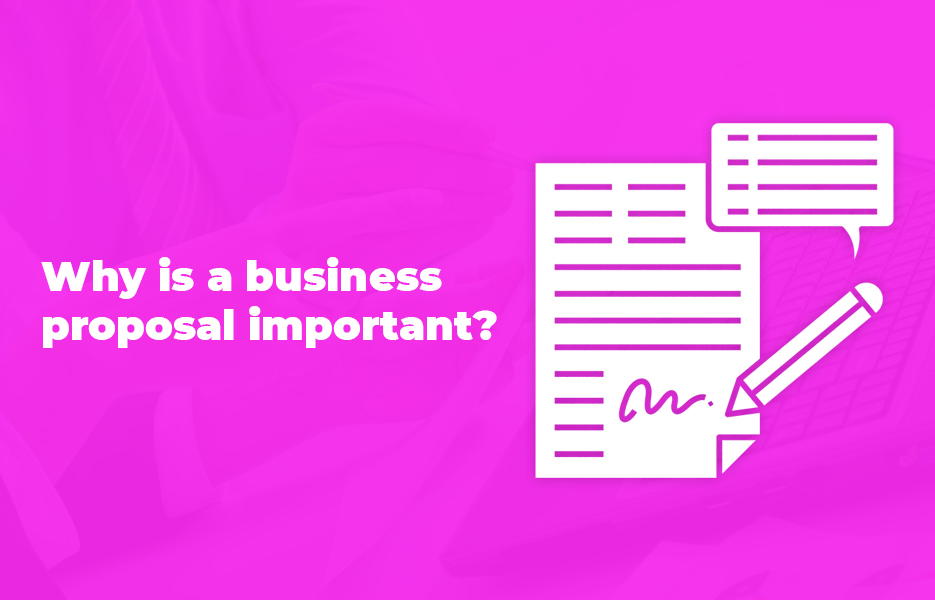
It is pretty unlikely that your business is the only one that is being considered. That means you’re going to need to impress your potential client, and fulfil the requirements of their brief with the best service, and providing value for money. You don’t want your hard work in finding the lead, and being asked for a proposal to be wasted!
It isn’t just about making sure your client knows you can do the job though. Your proposal is about giving clients confidence in your business, to help them know that your business is going to be reliable, with the right amount of attention to detail when you’re doing the work they need.
What should be included in a business proposal?
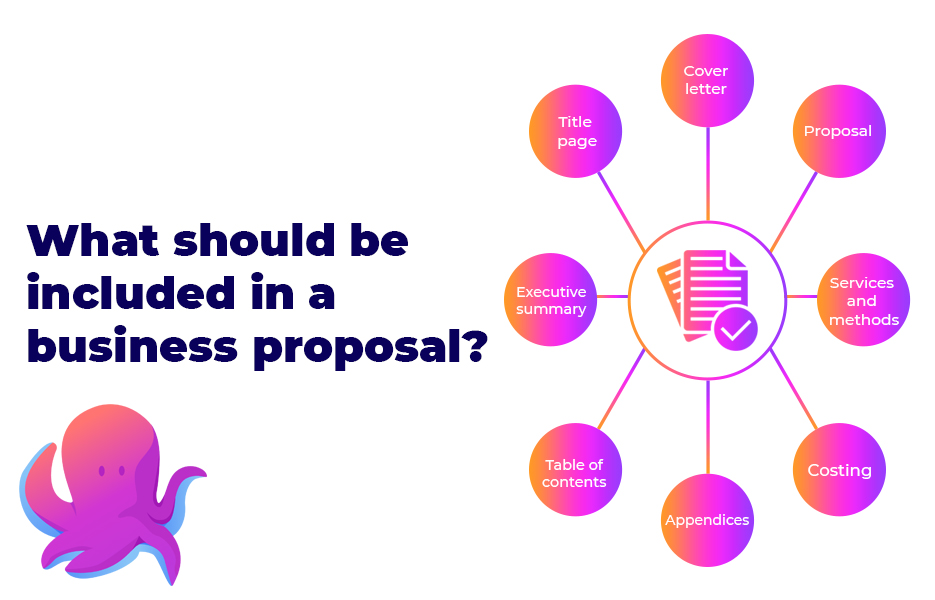
A business that has requested a proposal may have established what they require in the document. In those circumstances, obviously you should tailor the information as they requested. Otherwise, a basic business proposal template will include ten steps, plus the optional appendices with any additional information that may be necessary:
1. Title page
This should be simple and look professional, introducing your company and stating who the proposal is for.
2. Cover letter
Your cover letter should be friendly and positive in tone, and state why you’re sending it – “as per your conversation”, or “as requested on…” are the sort of statements that should be included. This is absolutely essential if your business is sending a proposal to a client who hasn’t requested it.
3. Table of contents
If your proposal is lengthy then make this clickable – don’t make it hard for your client to find the information they want first! If they have a budget in mind, they’ll want to jump straight to your pricing section to establish whether it is worth their time reading the rest.
4. Executive summary
Business owners and decision makers are busy – sum up your document with a summary will help your client make their decision about spending further time on your proposal.
5. Proposal
This section will discuss the requirements of the project, and the problem or gap in the business that needs to be resolved.
6. Services and methods
Clients want to know exactly how you are going to meet their requirements, and why those methods are best for them – so make it clear. Step-by-step details may be relevant, including things like who will work on their project, and the timeline you have in mind.
7. Reasons to work with you
Talking about your business should happen in this section. Tell your clients why you’re a better option than your competitors, where you have worked on similar projects and what the return on investment was. If your staff are particularly well qualified or have impressive experience, include that where it is relevant.
8. Costing
You want to get paid, and although the client may be looking for the best possible price, under-pricing your services may result in you being deemed ‘too good to be true’ and the client going elsewhere.
9. Terms and conditions
This isn’t the boring legal bit that nobody reads – this is the essential section about what the client should expect from your business when they agree to your proposal. Payment terms and project delivery timeframes can be included here.
10. Agreement and call to action
Whether you know that your client is keen to start the project with you or they’re still in the early stages of planning, make it easy for them to sign up. Include a page they can formally agree, and if you can use electronic signing, so much the better – it means you won’t have to wait to start work on their project.
11. Appendices
This is a basic outline of the sections that your business proposal is likely to require, but every business is unique, as are the needs of the businesses you are working with. You may need to include other sections to provide the right type of information, and you may need to add more information for some clients in your appendices.
Considerations for your proposal
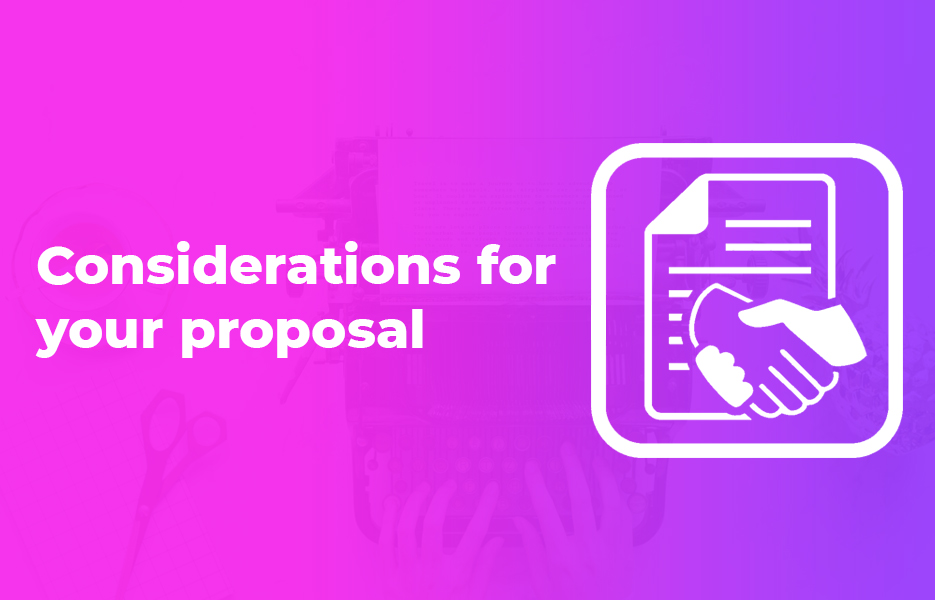
Before you get started, there are a number of things you will need to do, and to consider for each proposal that you create:
- Do your research. Knowing your potential customer will ensure that you can meet their requirements better. Learn about them from their website, social media, and if it is possible, meet with them in person. Doing so will allow you to create a good first impression, and help you to identify whether there are any other pain points that your proposal could eliminate, meaning you are more likely to get the job.
- Make every proposal unique. Although you can work with a template document to input a lot of the information, don’t be tempted to create a generic document and just search and replace the name of the client each time. Showing that you’ve done the research on the company, and considered how to improve the value of the work means you’ll be more likely to win the job.
- Establish the sort of detail your client is expecting. If they are looking for a one page overview and you send them twenty pages of in-depth detail, you’re likely to miss out. If you are good with PowerPoint, or can create a video proposal that can be viewed in less than five minutes, this may be a great way to provide much more information in a more easily digestible format. Your presentation or video needs to be suitably impressive though.
- Provide information that is easy to understand. If you can create a graph, or use an image to explain something at a glance, do so.
- Using positive language is more likely to result in your being awarded the job. Talking about how the job will end, use wording such as ‘resulting in a successful conclusion to the project’. It is a small thing, but is much more persuasive and wins people over.
Tips for business proposal success
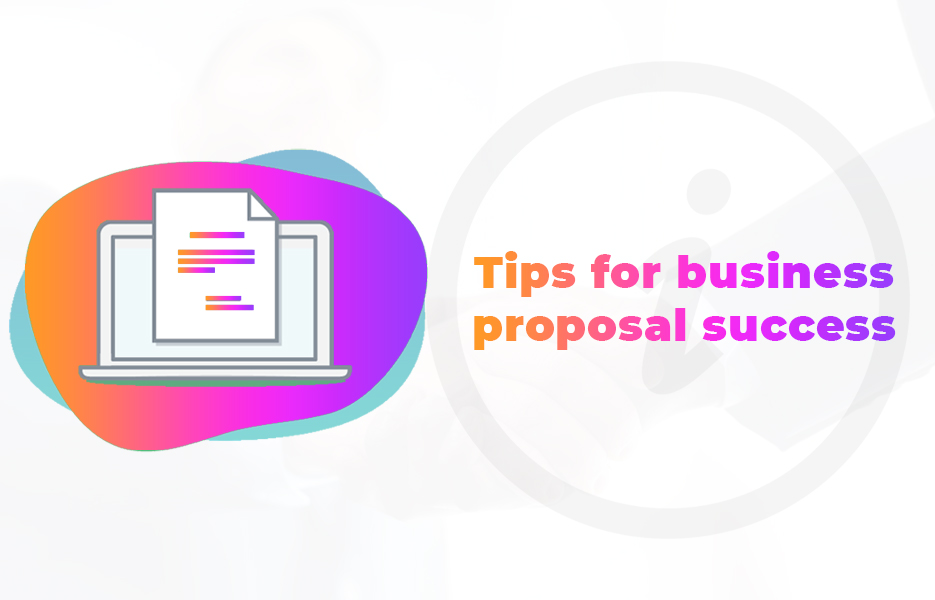
Many of these suggestions might seem like common sense, but our team have seen lots of proposal documents that have clearly not followed any of this advice!
- Check your proposal document makes sense. Proofreading is an essential step before you send your proposal – even if you’ve worked with a professional writer to perfect your proposal template, you’ll need to personalise it for each customer. Copy and paste is great, but mistakes can happen. Accidentally leaving the name of another business you’ve pitched to in your document, sentences that don’t make sense and forgetting to complete blank spaces can all lead to you losing the job to a competitor.
- Ensure your proposal provides the most value. What can you add to your proposal that will help to ensure you win the job, but won’t reduce your profits?
- Show that you have understood the customer’s needs. Your solution must align with what they need, or they will go to a company that understands and provides the right service. Make sure you have laid out clearly how you will meet their needs by providing a detailed plan.
- Make sure your proposal looks great. Don’t just send out a boring document in Times New Roman font! Your proposal can include graphics, and if you’re sending it electronically, sound files and video. The more impressive your proposal looks, the more likely it is that you’ll win the business – as long as you’ve met our other points.
Is a business plan the same as a business proposal?
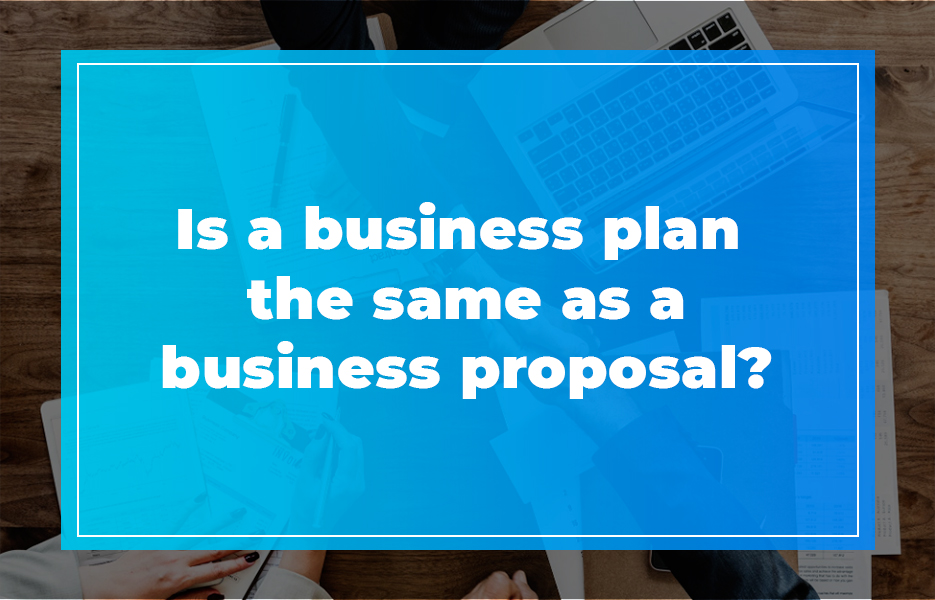
No, they are two different things. A business plan is used to establish whether an idea is a viable venture. Your business plan isn’t just about the reasons you should get started – it is equally as important to highlight the reasons to not start the business. A business plan should:
- Make it clear how much of a chance your business has of making a decent profit
- Establish how much your start-up costs will be
- Show whether you will need investment or to source finance
- Define your market and the percentage of that market
- Illustrate how the business will make money from the get-go through the marketing strategy
- Include an analysis of the competition, what they lack and how your business will differ
- List any anticipated problems, emergencies or risks that may need to be mitigated
Creating a business plan will ensure that if you need to secure funding from the bank, or investors, that everything is presented in a clear, easy to understand way. This is important to create confidence in your business idea, and will mean it is much more likely that you will be able to secure funding for your venture.
In simple terms, business proposals are a way to convey to a potential client what you are offering to meet their needs, the timescale for the project and the costings. Although they sound simple, they shouldn’t be created in a hurry or without much thought – you haven’t won the client’s business yet, so your proposal should impress.
- Be sure you completely understand the needs of your client, and can meet their brief with your proposed solution
- Each proposal you create should be unique – don’t just edit a generic document each time since this increases the chances of errors occurring
- Keep language positive, and use images, graphics and video to provide additional value where possible
- Ensure you have included all the relevant information – use a checklist
- Don’t skip the proofreading stage – mistakes will risk you being eliminated from consideration
Whatever your business proposal is for, making sure it has been created to the highest possible standard will give your business the best chance of winning the work. Good luck out there!

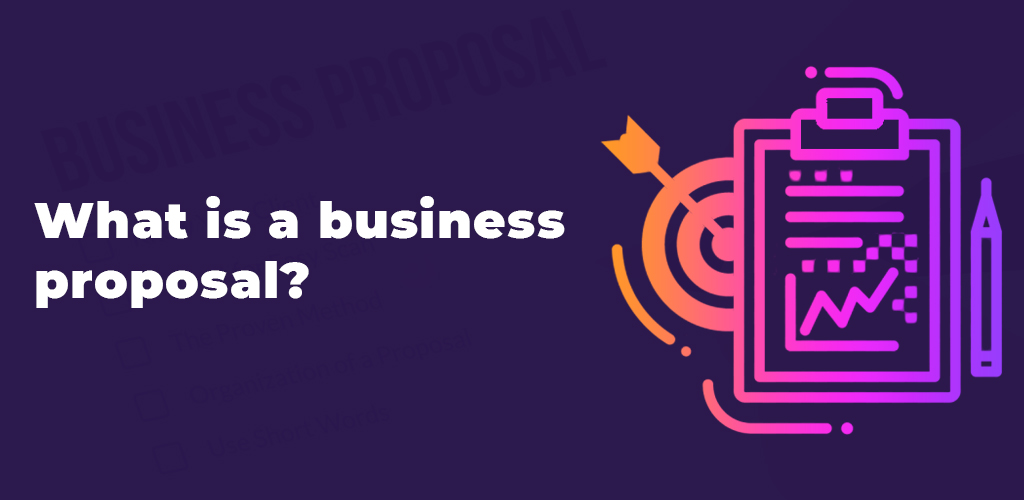


DropShip products from verified suppliers to diversify your inventory and scale your eCommerce business